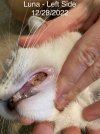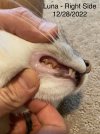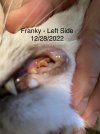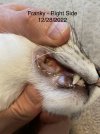I have two kitties that are from the same litter, Franky and Luna who are soon to be 7 years old. Gingivitis has taken hold and most of the infection is in their back teeth. I recently received the Deer Velvet and sprayed it on their back teeth. It took two of us to do it and they didn’t enjoy it. But we are going to try and do it daily.
I appreciate any tips on how often to spray Deer Velvet (daily/weekly?) and best methods to effectively get this product on their back teeth. We sprayed and got their teeth as best we could.
Background: Recently, we went to a local holistic vet who said they would need to do x-rays to see how deep the infection is, that they may need to remove teeth, and they use a flouride treatment (aluminum byproduct which I don’t believe will help) and it would cost $1,800 for each cat. I felt a bit limited in options, until we spoke with Dr. Jeff and ordered Deer Velvet. Do you think it can help stop the infection and save their teeth after seeing the photos? Any success stories would be appreciated ? If they need teeth removed we’ll take them to do so, we’re just hoping to get them to a better state as much as we can.
I had the feeling to brush their teeth with fresh aloe vera, is this something that is helpful and not harmful? I purchase fresh aloe vera often (store bought, grown for consumption).
Current plan: today I started the deer velvet spray. How often should we use this spray? Also, I plan to take photos about 60 days after starting deer velvet, is this enough time to start seeing improvements or should we wait longer?





I appreciate any tips on how often to spray Deer Velvet (daily/weekly?) and best methods to effectively get this product on their back teeth. We sprayed and got their teeth as best we could.
Background: Recently, we went to a local holistic vet who said they would need to do x-rays to see how deep the infection is, that they may need to remove teeth, and they use a flouride treatment (aluminum byproduct which I don’t believe will help) and it would cost $1,800 for each cat. I felt a bit limited in options, until we spoke with Dr. Jeff and ordered Deer Velvet. Do you think it can help stop the infection and save their teeth after seeing the photos? Any success stories would be appreciated ? If they need teeth removed we’ll take them to do so, we’re just hoping to get them to a better state as much as we can.
I had the feeling to brush their teeth with fresh aloe vera, is this something that is helpful and not harmful? I purchase fresh aloe vera often (store bought, grown for consumption).
Current plan: today I started the deer velvet spray. How often should we use this spray? Also, I plan to take photos about 60 days after starting deer velvet, is this enough time to start seeing improvements or should we wait longer?
- Your pet's name: Luna & Franky (litter siblings, bonded as kittens)
- Approximate age: currently 6 years old, they will both be 7 yrs old in February 2023
- Sex Female & Male
- Neutering status Yes (both)
- Breed Siamese & Tabby mix (both)
- Approximate weight: Luna is 10 lbs and Franky is 12 lbs
- What's their BEAM (behavior, energy, appetite, mood) All are good, except Luna sometimes seems to have difficulty eating as she is eating more slowly than her brother (she used to eat more quickly than him).
- Diet Raw Turkey from Darwin’s, cooked unsalted wild caught salmon (human food) & unsalted wild caught canned sardines (human food). *They are trying Viva Raw Rabbit this week*
- Vaccination history / exposure to toxins, other medication: Right when we adopted them, they had ringworm so we didn’t know any better and gave them oral anti-fungals and took them to vet for sulphur baths for a 2 month period. Then later they showed symptoms of a herpetic virus because their eyes would become severely swollen. They were given steroids and antibiotics several times. Then later we learned to give them L-Lysine and that symptom hasn’t come back. They now take the Vimergy L-Lysine, Vimergy Micro-C, and Life Line Icelandic Kelp. They received vaccines up until Sept 2019. They don’t get them any longer.
- Primary problem, when it began and if there was anything else happening around that time - They’ve had gingivitis since they were young. It’s gotten worse. I wasn’t sure what to do next, so I will be trying Deer Velvet.
- Is the condition better or worse from exercise, heat, cold, time of day, certain foods, emotional upset, being touched, excitement, etc? Not sure what makes gingivitis better, nothing we’ve tried up until now has made it better.
- Has any diagnostic work been done? Diagnosis if available (you can attach your diagnostic tests to the post if you have them) I posted photos for both kitties.
- Current and previous treatment tried brushing but too difficult. We considered getting teeth cleaning treatment but they use flouride so it doesn’t seem like it will work and may do more harm than good.
- Other health concerns: none currently.





Last edited:
